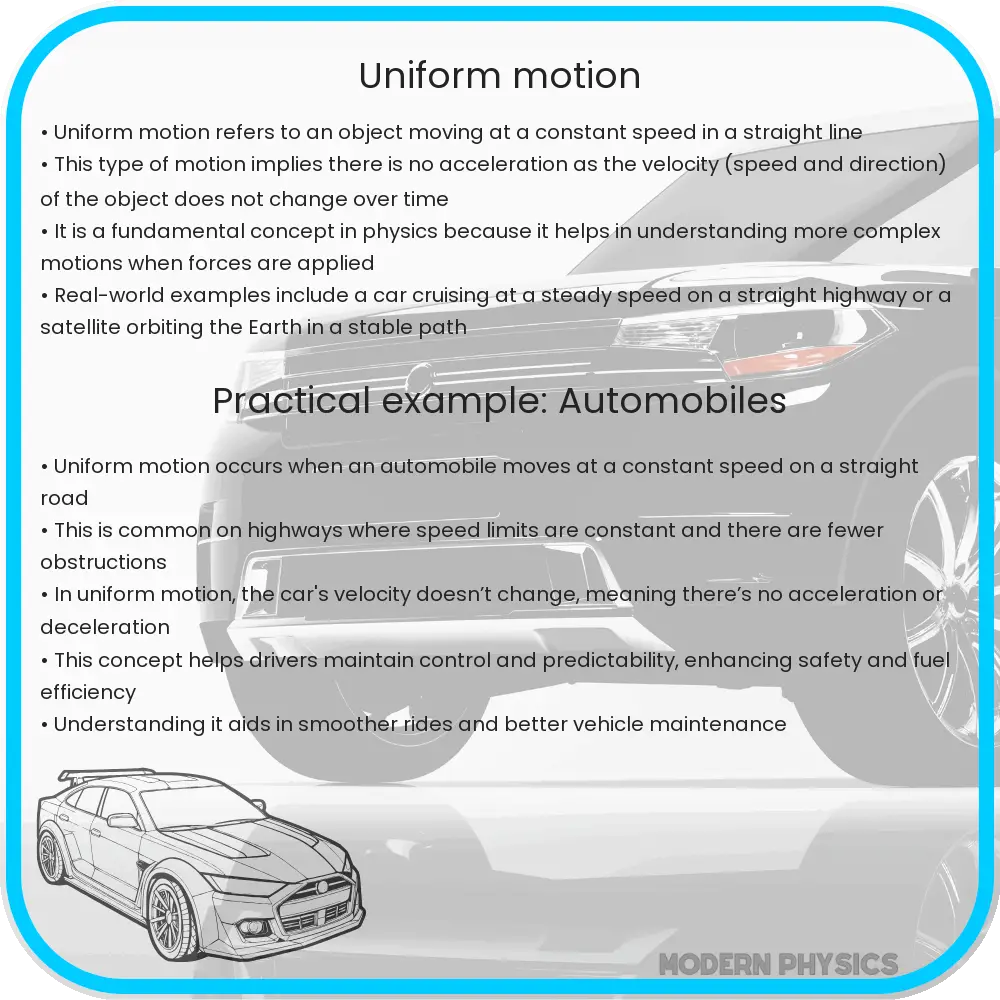Explore the basics of uniform motion in kinematics: characteristics, examples, mathematical analysis, graphical representation, and real-world applications.

Understanding Uniform Motion in Kinematics
Kinematics is a branch of mechanics that focuses on the motion of objects without considering the causes of this motion. One of the fundamental concepts in kinematics is uniform motion, a type of motion where an object moves along a straight path at a constant speed. This means the object covers equal distances in equal intervals of time, regardless of the length of the time intervals.
Characteristics of Uniform Motion
- Constant Speed: The object doesn’t speed up or slow down; it maintains the same pace throughout its motion.
- Straight Path: The trajectory of the object is a straight line, without any turns or curves.
- Consistent Direction: Along with a straight path, the object also keeps a consistent direction.
- Equal Distances in Equal Times: This is a key characteristic, implying that if an object travels 10 meters in the first second, it will travel 10 meters in every subsequent second of its motion.
Examples of Uniform Motion
Examples of uniform motion are less common in the real world due to various forces acting on moving objects. However, some idealized examples include:
- A car moving at a steady speed of 60 km/h on a straight highway.
- A satellite orbiting the Earth in a stable path with a constant speed.
- A conveyor belt moving at a fixed speed in a factory.
Mathematical Analysis of Uniform Motion
In mathematics, uniform motion is often represented using simple equations that demonstrate the relationship between distance, speed, and time. The basic formula is:
\[ Distance = Speed \times Time \]
Where:
- Distance is the total path covered by the object.
- Speed is the constant rate at which the object is moving.
- Time is the duration for which the object has been moving.
These equations are fundamental in understanding the basics of kinematics and are crucial in more complex studies of motion.
Graphical Representation of Uniform Motion
The uniform motion of an object can be effectively visualized using a distance-time graph. In such a graph:
- The x-axis represents time.
- The y-axis represents distance.
For an object in uniform motion, the distance-time graph is a straight line with a constant slope. This slope represents the speed of the object. The steeper the slope, the faster the object is moving.
Real-World Applications and Limitations
Understanding uniform motion is crucial in various fields, including physics, engineering, and transportation. For instance, it helps in designing vehicles that can maintain a steady speed for fuel efficiency. In sports, athletes and coaches use the concept to improve performance in activities that require constant speed.
However, it’s important to note that real-world scenarios often involve non-uniform motion. Factors like friction, air resistance, and other forces usually cause objects to experience changes in speed and direction, making the concept of uniform motion more of an idealized situation than a common reality.
Conclusion
Uniform motion, characterized by movement in a straight line at a constant speed, is a fundamental concept in kinematics. While its pure form is rare in the natural world due to various external forces, the principles of uniform motion are essential for understanding more complex types of motion. The concept finds practical application in technology, transportation, and sports, among other fields. Moreover, it serves as a foundational block for students and professionals in physics and engineering, providing a basis for exploring more intricate aspects of motion and mechanics. Ultimately, the study of uniform motion not only deepens our understanding of physical principles but also enhances our ability to innovate and solve practical problems in our world.
